American art in the 1960s expanded, and sometimes exploded, the ideas of what painting and sculpture could and should be. Pop art took images from the commercial world — think Campbell’s soup cans — and created new meanings for them. It also experimented with new tools and materials, from high-tech lasers and holograms to commercial neon signs.
The Norton Simon Museum in Pasadena, California, has mounted a small gem of a show, Plugged In: Art and Electric Light, featuring Pop works from 1964-70 that are powered by electricity. Across town, California Institute of Technology has organized Crossing Over: Art and Science at Caltech, 1920-2020, a group of contemporary artworks and historical collections across the campus. Both exhibitions display the power of light and energy and fit in nicely with the Getty’s sprawling PST Art series of exhibitions across Southern California called Art & Science Collide.
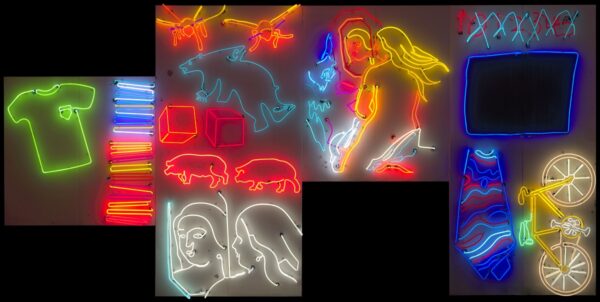
One of the most spectacular works at the Norton Simon is Robert Rauschenberg’s Green Shirt of 1965-67, a 20-foot-wide panel supporting a dozen images created with neon lights. There’s the green shirt of the title on the left, as well as a young blond woman riding in a saddle and another looking at herself in a mirror. There’s a pair of orange pigs and a flying blue bear, a yellow bicycle and a striped necktie.
Shaped like a billboard, the work is really an advertisement for itself. It exudes the optimism (and chaos) of the 1960s in an explosion of imagery.
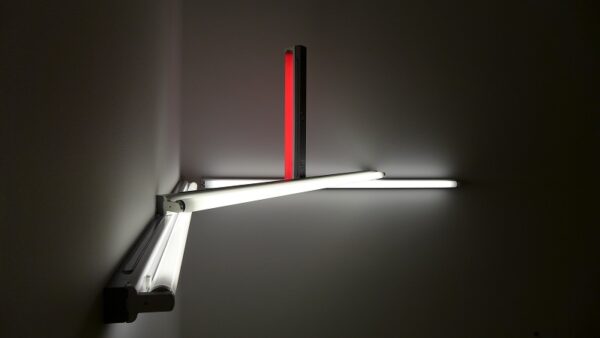
Some of the works in the show are minimal in the extreme. Laddie John Dill, for example, uses neon tubing to create a single horizontal line with a dozen foot-long segments at eye level in a variety of colors. Dan Flavin’s “monument” on the survival of Mrs. Reppin of 1966 consists of one red and three white, fluorescent lighting tubes, ordinary commercial products that are artfully arranged in a corner. Both works have a simple elegance that catches your eye.
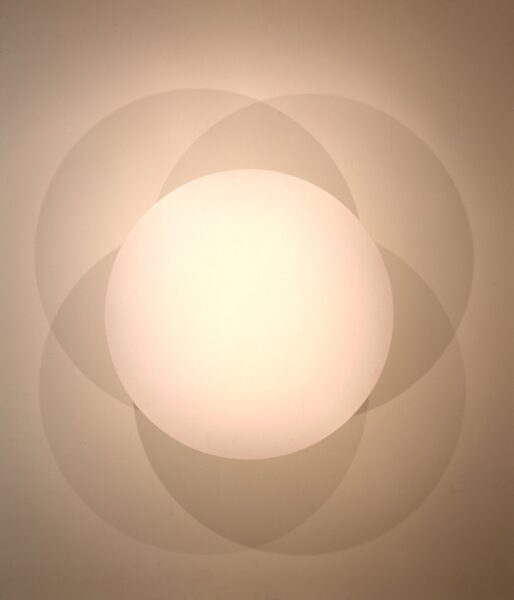
A much showier sculpture, Robert Irwin’s Untitled of 1968, presents a slightly convex, creamy white disc, 5 feet in diameter and seeming to float in front of the wall. It’s lit by four spotlights above and below that cast four different but symmetrical shadows on the wall, creating a complex of overlapping shadows that surround the disc like a halo. The work seems simple at first glance, but the more you study it and move around it, the more complex it becomes.
Plugged In: Art and Electric Light runs through February 17, 2025, at the Norton Simon Museum, 411 West Colorado Boulevard, Pasadena, California. The museum is closed on Tuesdays and Wednesdays.
Top image: Robert Rauschenberg (1925-2008), Green Shirt, 1965-67, neon and enameled metal; Norton Simon Museum, gift of the artist, © 2024 Robert Rauschenberg Foundation / Licensed by VAGA at Artists Rights Society (ARS), New York.
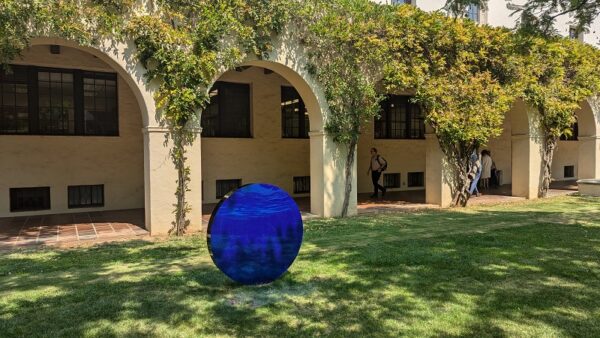
Crossing Over at Caltech
If you enter the Caltech campus from the west side, walking along the grassy Bechtel Mall framed by the oldest buildings at the school, the first things you see of the Crossing Over series are Shana Mabari’s Spectrum Petals. This wonderful series of seven sculptures – each a smooth plastic disc about 3 feet in diameter and 6 inches thick – are spread across the lawn, standing on edge as if they just landed from outer space.
The discs — in red, blue, green, yellow, orange — look like semi-transparent lenses, perhaps designed for a large telescope. In fact, they’re slightly reflective, casting odd bands of color on the grass. (The squirrels foraging on the lawn near a disc seem spooked by the appearance of an identical squirrel looking back at them.)
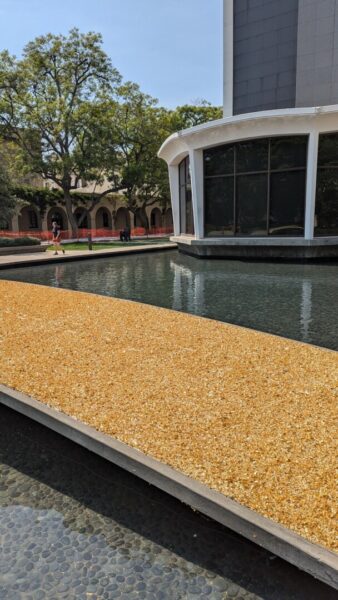
Farther down the mall, environmental artist Lita Albuquerque has created another striking outdoor artwork, This Moment in Time. She’s covered a small bridge over a reflecting pool with a synthetic gold leaf material that looks a lot like a shag rug. The metal fabric reflects the sunlight, sways in the wind, and would be right at home with Judy Garland in The Wizard of Oz.
Inside three buildings flanking the mall are small exhibitions showing how Caltech scientists have made important contributions to modern science. Using historical documents, photos, and prints, the installation in Linde Lab focuses on the development of modern astronomy, including the building of the Mount Wilson and Mount Palomar observatories. There’s also an elegant new artwork, a glowing golden disc mounted on a blue background titled Helium Blaze, also by Albuquerque.
The installation in Gates Annex, called Time Stream, also focuses on astronomy and physics and displays rare first-edition books by Copernicus, Galileo, and Kepler, among others. At Dabney Hall, the Powers of Ten explores the idea of scale, from the vastness of the universe to the subatomic. It also documents the important contributions made by Caltech scientists to the sobering topic of the Manhattan Project, which developed the atomic bomb during World War II.
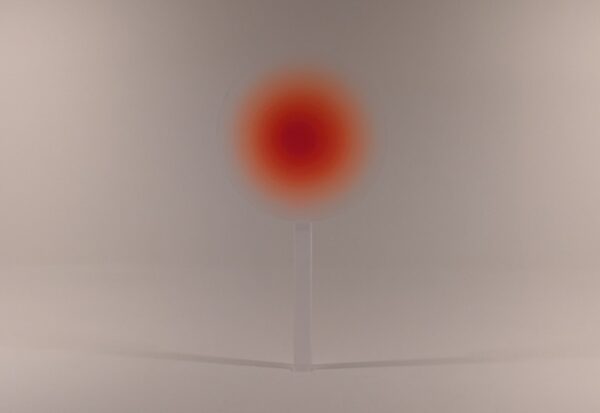
courtesy of Helen Pashgian ; photograph by Stephen West.
A fourth mini-exhibition, at the Chen Building north of the mall, features a single artwork by Helen Pashgian. This spooky, untitled work of 2023 employs a resin-based “radiant lens” to project a glowing red-orange fuzzy ball of light in a darkened room. The image seems to pulse slightly, changing shape and color just a bit if you move around the room and meditate on the mysterious work. You might consider it a high-tech, 21st-century descendant of Robert Irwin’s glowing white orb at the Norton Simon.
Crossing Over: Art & Science at Caltech, 1920-2020 runs through December 15 at California Institute of Technology, 1200 East California Boulevard, Pasadena, California. A catalog is available. The installations are closed on Mondays and Tuesdays.
